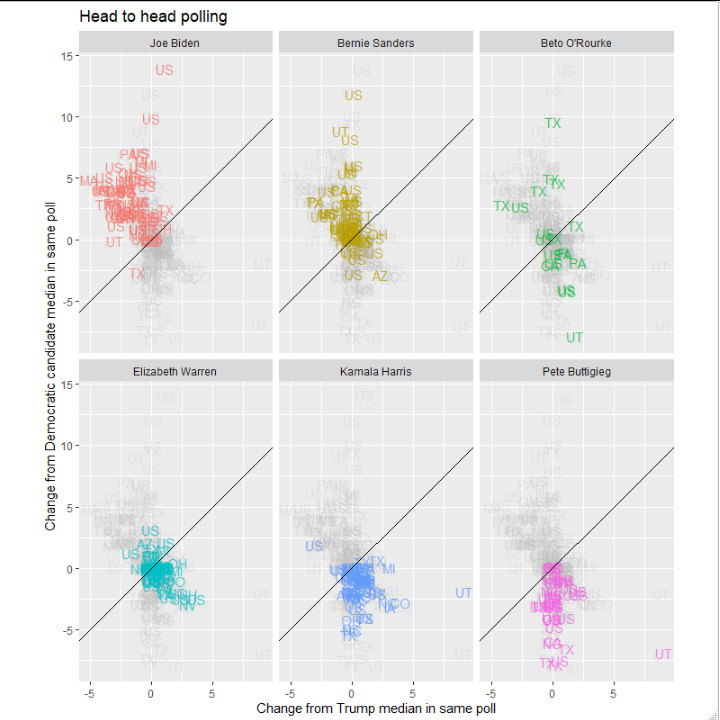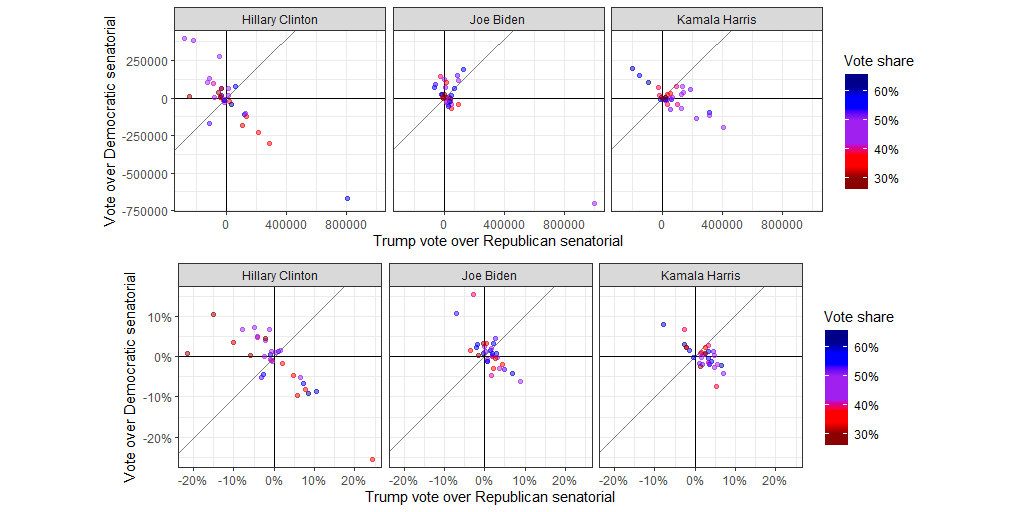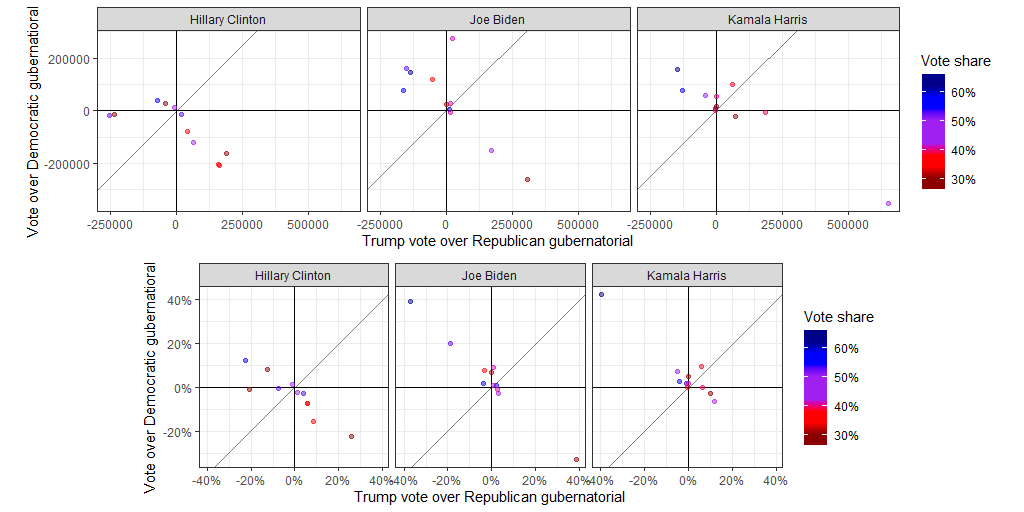I told you so: Democrats made a bad bet
Kamala Harris underperformed; don't defend the decision.
This is not the long article laying out how things got to where they are today, or the series of continued failures by both major American political parties stretching back for a decade. That article will come, along with others. Hit the “subscribe” button to get them delivered into your e-mail box.
Today, I’m going to talk about something simple, something that is obvious to me from the numbers but clearly not obvious to everyone: Kamala Harris was a weak candidate, and the flaws in her candidacy and campaign were an important factor in why the Democrats lost.
Democrats could have bet on a repeat of 1948 or against a repeat of 1968.1 They chose the latter bet with Kamala Harris.
Kamala Harris didn’t just fall out of a coconut tree
One of the major problems with Kamala Harris as a candidate is her history. While not exceptionally progressive as California’s attorney general relative to California politics, her Senate record identified her one of the two farthest-left senators and three farthest-left members of the entire 116th Congress.2 She ran for the Democratic presidential nomination in 2019 in the “left” / “progressive” lane, which positioned her on the losing side of many of the issues that mattered to 2024 voters.3

Unsurprisingly, she had bad favorability polling and bad head-to-head polling. She even had a weak electoral record in California, which was not a battleground state at the time. All factors pointed to her being among the weakest candidates early on,4 even initially when the media coverage of her campaign was largely positive in tone.5 Five years ago, my best estimate was that Kamala Harris could be expected to underperform the typical Democratic candidate by 2.5%.6
Kamala Harris clearly underperformed on the ballot
One of the major techniques I’ve used for estimating the electability of various candidates is comparing them to other candidates on the same ballot.7 While Kamala Harris and Donald Trump were the only candidates listed on ballots in all fifty states, many other candidates ran for statewide office at the same time, including thirty-four running for federal office.

Hillary Clinton won and lost states in tandem with Democratic senators, although sometimes by considerably different margins. Joe Biden won one state that elected a Republican senator; Kamala Harris lost several key battleground states that nevertheless elected Democratic senators.
If we compare votes for senators and presidents - both federal offices! - Biden’s performance looks clearly superior to that of Kamala Harris. He earned more votes above the senatorial baseline, he held Trump to fewer votes above the senatorial baseline, and this is true whether we look at average or typical values. Typically, Biden performed 1.1% behind senatorial candidates, and Kamala Harris performed 2% behind senatorial candidates. If we focus on net percentage margins, Kamala Harris also underperformed Hillary Clinton.8
Now, there is a problem with this benchmark: These are three different collections of states. The Senate has a very curious rhythm to it related to incumbency and the countercyclic midterms. However, there are a group of high-profile politicians who face election in the same states at least once every four years: Governors.
There are some striking outliers, which gives a strong motive for looking at median values. Joe Biden’s median performance was 5.9% ahead of Democratic governors, while Kamala Harris’s median performance was 2.9% ahead of Democratic governors, a whopping 3% difference. Hillary Clinton’s median performance was 3.9% behind Democratic governors.
Now, that said, gubernatorial races can vary quite remarkably from normal partisan behavior. Kamala Harris’s worst battleground state performance relative to a gubernatorial candidate is a clear outlier: Josh Stein’s defeat of Mark Robinson in North Carolina was the most lopsided gubernatorial race in the state since 1980. However, North Carolina has a large number of statewide elections during presidential election years, including the entire Council of State.

While Hillary Clinton showed signs of substantial overall undervoting, her typical net margin was 1% better than the typical Democrat running statewide in North Carolina, and the same was true for Joe Biden. However, Kamala Harris typically performed 1.5% worse - a gap of 2.5% between Harris and Biden relative to baseline partisanship in North Carolina.9
Democrats coming home: A deceptive polling surge
I’ve noted that polling showed many unusual characteristics this year. For example, polling overestimated Trump’s performance in presidential primaries while underestimating Biden’s performance. Kamala Harris’s approval rating shows a particularly interesting pattern:

At the beginning of the Biden administration, Harris’s net approval ratings generally lagged about 5% behind Biden. Over time, her approval ratings generally converged with Biden’s as Biden’s approval rating declined and reached an apparent partisan floor. Due to the fact that a significant but vocal minority of Democratic partisans wanted to substitute another candidate for Biden, I expected Democrats to “come home” once the nomination was settled, as has happened with both parties in previous intraparty conflicts.10
The moment Harris became the presumptive nominee, however, there was a sharp discontinuity in Harris’s approval ratings. It is likely that this discontinuity did not reflect any sudden change in approval of Harris among swing voters; instead, it probably reflected a shift in response rates that also impacted head-to-head polls.11
Candidate quality matters, not just platform
Blueprint 2024’s issue-oriented exit polling sought to identify the top reasons why voters voted against Harris: Cultural issues, inflation, and immigration. I’ll talk about this more in a later article but one key point I will emphasize is that “Democrats are too liberal” simply did not resonate with swing voters who cast ballots for Trump.12
The fact of the matter is that while Democrats as a party as a whole have embraced a number of unpopular positions on immigration and cultural issues and Democrats as the governing party have been blamed for inflation, these are problems that impacted downballot Democrats as well. I expected Democrats to stick with Biden as their nominee for three very concrete reasons:
On the fundamentals, replacing the presumptive nominee at the last possible minute is an extremely risky move.
If Biden were to voluntarily step aside, the only plausible choice was Kamala Harris, who was very clearly a weak candidate.
The Democratic Party has been very keen to avoid repeating the mistakes of 1968.
While we cannot know how Biden would have performed, it is now clear both that Democrats repeated several of the mistakes of the 1968 election and that Kamala Harris proved to be a weak candidate. Those who led the campaign to pressure Biden cannot reasonably claim to be vindicated in their decision.13
Not only has she become the first candidate to lose the popular vote to Trump, she did so in environments where in spite of any negative coattails she brought to the election, Democrats still were able to win statewide elections on the same ballot in key battleground states, including Michigan, Wisconsin, North Carolina, Nevada, and possibly Arizona.14 Candidate quality matters.
As I cautioned this summer. See “Echoes of 1892, 1948, 1968, and 1984” from June.
According to VoteView’s DW-Nominate, Kamala Harris’s score was less extreme than Elizabeth Warren and Sylvia Garcia.
As I discussed in “How to lose the 2024 election” in June, appealing to the median voter matters. On many issues where Trump and Biden differed with the median voter lying between the two of them, Kamala Harris put herself on the record in 2019 as endorsing an extreme policy. E.g., she pledged to decriminalize border crossings, rolling back a law that has been on the books since 1929; exit polling has highlighted that immigration remained one of the most important issues for swing voters.
"Electability and the Blue Bubble,” from October 2019.
Overall, she ended up with a proportionate volume of coverage, and the negative coverage near the end of her campaign may have made up for that. See "Media bias in the Democratic Primary,” November 2019.
"Electability and the Senate in 2020,” from January 2020.
Including both real elections and polls. Just as states have different levels of baseline partisanship, polls have different levels of baseline partisanship due to sampling methods and also random chance.
Hillary Clinton’s performance was more varied and a little harder to evaluate; she achieved the unusual feat of earning fewer raw votes than senatorial candidates, but while her net margins were high variance, they were actually perfectly in line with Democratic senatorial candidates. That said, Democratic
The gap between Biden and Harris increases to 3.0% if we use mean values instead of median values, but this is largely due to the aforementioned outlier. The Clinton-Harris gap stays constant at 2.5%, though, because there was a significant gap between a minority of higher-performing Democrats and a majority of lower-performing Democrats in 2016.
See most particularly Trump’s numbers in 2016.
This could help explain why polls consistently overestimated the protest vote against Biden during the primaries while simultaneously overestimating Kamala Harris’s support. An additional factor is that relative to Joe Biden, Kamala Harris’s popularity was higher among elites while lower among the working class, something exhibited to great effect during the 2020 primary cycle.
“Democrats are too liberal,” -4 among swing voters overall, vs +1 issue importance among voters overall. By contrast, “Kamala Harris is too liberal” registered at +4 with this group.
As a matter of historical reality, many of the key figures involved in the pressure campaign either publicly supported Biden’s nomination leading into the primary process or opposed Biden’s nomination in 2020 in the first place.




